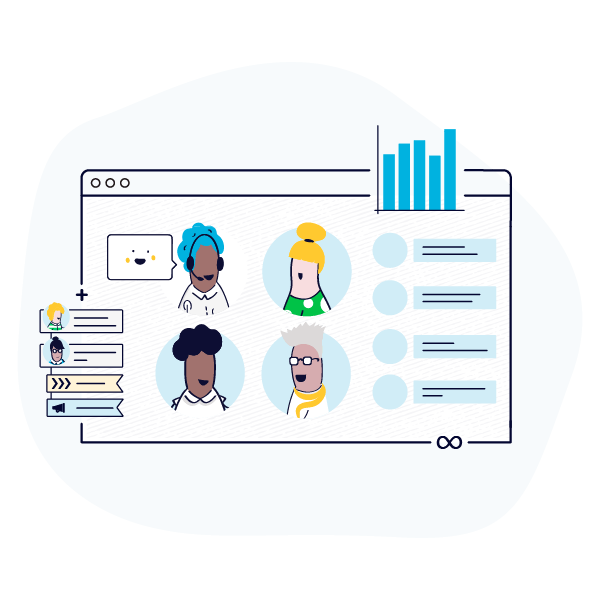Using automation in email campaigns

“Nutshell is super user-friendly and intuitive

“I would highly recommend Nutshell

“Easy to use and... wait for it ... 100% buy in!

“Nutshell is both simple and powerful
You know those tasks where you can’t help but think, “I wish there were a simpler way to do this?” From having to constantly recreate emails for campaigns to jumping between platforms to collect data, these things eat up time in your day. By automating and streamlining marketing processes, you can put those tasks to the side.
With the help of a CRM like Nutshell, you can automate your sales and marketing processes, improve your business’s efficiency, and make more time for wowing customers. Don’t have Nutshell yet? Get started today with a free trial, or contact us online to speak with one of our CRM specialists.
Automating lead nurturing, email campaigns, and follow-ups saves time and ensures consistent, personalized engagement across the customer journey.
CRM-integrated workflows and reporting eliminate manual tasks while delivering real-time visibility into performance metrics.
Tools like chatbots, segmentation, and triggered messages help marketing and sales teams scale outreach without sacrificing quality or relevance.



Take our guided tour to explore Nutshell’s incredible features!


You know the saying, “Work smarter, not harder?” When you use automation in your sales and marketing efforts, you can streamline processes and improve your team’s efficiency. In doing so, you can better collect customer data, improve your customer engagement, and manage your team’s workflow. Here’s how:
Learn more:

Email campaigns are a great way to nurture leads and stay at the forefront of your current customers’ minds. Automated email campaigns, on the other hand, are even better. Automation for email campaigns can help you improve customer engagement and effectively reach your target audience at the right time.
Learn more:

Creating email templates can help you save time and effort when developing new campaigns. With customizable email templates, you can ensure your campaigns are consistent in design and messaging.
Furthermore, you can set up automated email sequences that are triggered by specific events or actions. That way, you don’t constantly have to hit that “Send” button.

Segment your email lists more efficiently by using automation to better analyze customer data for trends, patterns, and other valuable insights. With that information, you can segment your audience and launch campaigns that are perfectly tailored to your audience segments.
![]()
With your Nutshell CRM, you can use its built-in email marketing software to automatically track and measure the performance of your campaigns. Track metrics like click-through rates, open rates, and conversion rates all from one place while hardly lifting a finger by implementing email automation tools with your CRM.

As a business owner, you’re always looking for ways to improve the customer experience. Not only does a positive customer experience make your business look good, but it encourages customers to stick with your brand.
By using automation to improve customer experience, you can ensure your customers always walk away from a transaction with nothing but good things to say.
Check out a few ways you can use automation to improve the customer experience for your business:

Automating your data analysis and reporting processes is an effective way to make data-driven decisions and improve your sales and marketing strategies. By incorporating automation into your data reporting, analysis, and data visualization tools, you can create more effective and efficient sales and marketing campaigns.

Automating the reporting process can make accessing key customer information easy. With a CRM, you can instantly access easy-to-use reports with up-to-date data.
Additionally, you can indicate you want your automated reports to include key metrics related to your sales goals, like website visits or conversion rates, so you can accurately measure your campaign’s success.

When it comes to customer data, automation integration doesn’t stop at data reporting. With CRM automation, you can enhance your data analysis processes to gain better insights into customer behavior and preferences.
Automation for data analytics can help you pinpoint key trends and insights into customer purchase histories, browsing behaviors, and campaign engagement.
Understanding customer behaviors and characteristics through automated analyses can help businesses better understand the needs of their customers and use that information to create campaigns tailored to key customer segments.

Visualizing customer data is helpful, especially when trying to discern trends and patterns within it. Automating data visualization tools alleviates headaches when trying to make sense of large amounts of data. From generating simple graphs to detailed charts, data visualization with your CRM will quickly become a common practice for your team.

Automation in marketing offers a wide range of benefits, including helping businesses improve efficiency, decision-making, customer engagement and experience, accuracy, scalability, and campaign personalization.
Read on to get a deeper understanding of why these benefits aren’t ones your business should pass up.
Learn more:

Automation in marketing helps to alleviate the chances of human errors or inconsistencies that could affect the outcome of campaign efforts. With the help of automation, your marketing efforts are more scalable—while non-selling tasks are automated, additional time and effort are freed up for your team to take on larger volumes of data and customers.
 Through customer data collected via your CRM’s automation tools, you can create personalized campaigns that are tailored to your customer segments. These campaigns can lead to improved customer engagement, increased conversion rates, and more positive customer experiences.
Through customer data collected via your CRM’s automation tools, you can create personalized campaigns that are tailored to your customer segments. These campaigns can lead to improved customer engagement, increased conversion rates, and more positive customer experiences.
“Automating and streamlining sales and marketing processes” means leveraging technology, primarily your CRM, to perform repetitive tasks automatically and optimize workflows for maximum efficiency. Think of it as taking all those manual, time-consuming steps—like sending follow-up emails, updating contact records, or assigning leads—and letting smart software handle them for you. This isn’t just about saving time; it’s about creating a seamless, consistent, and highly effective journey for your prospects and customers.
In today’s fast-paced market, it’s crucial for business growth because it allows your teams to:
Ultimately, it’s about working smarter, not just harder, to accelerate growth and stay competitive.
A CRM isn’t just a contact database; it’s the central nervous system that powers the automation and streamlining of both your sales and marketing functions, bringing them into perfect harmony.
For marketing, a CRM enables:
For sales, a CRM streamlines processes by:
By centralizing data and automating workflows, a CRM ensures a smooth handoff between marketing and sales, eliminates manual errors, and provides a unified view of the customer journey, ultimately driving efficiency and revenue.
Successfully automating your sales and marketing workflows isn’t just about making things a little easier; it unlocks a cascade of significant benefits that directly impact your bottom line and long-term growth. Here are the most impactful gains you can expect:
These benefits collectively lead to a more agile, responsive, and profitable business operation.
While the promise of sales and marketing automation is exciting, the path to successful implementation isn’t always without its bumps. Many businesses encounter common pitfalls that can hinder their progress. Being aware of these challenges and planning for them is key to a smooth journey:
By proactively addressing these challenges, you can ensure your sales and marketing automation efforts truly deliver on their promise, driving efficiency and growth without unnecessary headaches.
Implementing sales and marketing automation effectively within your CRM is a strategic journey, not a one-time setup. To ensure success and maximize your ROI, follow these key steps and best practices:
By following these best practices, you’ll build a robust, efficient, and customer-centric sales and marketing engine that drives sustainable growth.

Accurate and detailed reporting on customer data and campaigns through automation improves your team’s decision-making. With automation reducing the chances of human error or inconsistency, your sales and marketing teams can make campaign decisions confidently, backed by accurate data.

Best of all, automation in marketing is cost-effective because it helps businesses to avoid doing repetitive activities manually and frees up more time for your team to focus on high-priority tasks like connecting with valuable leads and closing sales.
Table of Contents

By automating and streamlining sales and marketing processes with your CRM, you can improve efficiency and drive growth for your business. With the help of automated email campaigns, data analysis and reporting, and more, you can continue to deliver quality customer service to your audience with increased efficiency and success.
Learn more about how Nutshell can help you automate sales and marketing processes today by contacting us online to speak to a CRM specialist. You can try Nutshell for yourself by starting a free trial.

Join 30,000+ other sales and marketing professionals. Subscribe to our Sell to Win newsletter!
